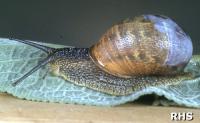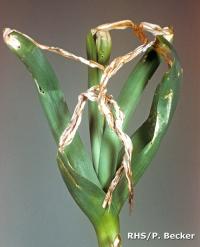Slugs and Snails Top the RHS Pests List
 Common garden snail (Helix aspersa)
Common garden snail (Helix aspersa)Slugs and snails are the most common garden pests, damaging a wide variety of plants. It's hardly surprising then that they top the RHS' list of the top 10 garden pests.
Every year the RHS receives thousands of calls regarding common garden pests. From these requests for assistance the RHS compiles a list of the most common pests across the country.
Last year slugs and snails were the top pests in gardens and allotments according to the RHS, with the greatest damage caused by these pests being from spring to autumn.
The 2011 Top Ten Garden Pests
- Slugs / Snails
- Cushion scale
- Vine weevil
- Ants
- Viburnum beetle (last year's winner!)
- Fuchsia gall mite
- Cypress aphid
- Leek moth
- Chafer grubs
- Mealybugs
New Pests
Fuchsia Gall Mite
The microscopic Fuchsia gall mite (making its début on the RHS list in sixth place) significantly impacts the growth of Fuchsias and was first seen in the UK only four years ago. The Fuchsia gall mite feeds on the tips of the Fuchsia's shoots and in their flower buds causing distorted growth of leaves and flowers. Since its discovery it has established itself along the south coast of England and is now beginning to move north.
“Unfortunately there are no effective pesticides for garden use. Because the damage cannot be controlled, it may lead to a decline in the popularity of this valuable garden plant,” says RHS Principal Entomologist Andrew Halstead.
Leek Moth

Leek moth (Acrolepiopsis assectella) is also a new entry on the RHS pests list, appearing in eighth place. Whilst this pest mainly affects leeks, it can also affect some shallots and onions. The photograph to the right shows Leek moth on a Leek (Allium porrum).
The Leek moth typically produces two generations of caterpillars during the gardening season, although its the second generation produced in late July to August that is the most problematic. The adolescent caterpillars mine the leaves and then bore into the leek's stem or the onion/shallot's bulb. Infested plants frequently become infected with secondary rot and subsequently perish.
Like the Fuchsia gall mite the Leek moth is predominantly found in the south of England and is also seen to be moving north.
“There are currently no suitable pesticides for use on these plants in gardens and allotments. Growing the plants under fine insect-proof mesh to prevent egg-laying moths and flies alighting on the foliage is the only remedy,” says Andrew Halstead.
Article posted on 21 Jan 2012.

